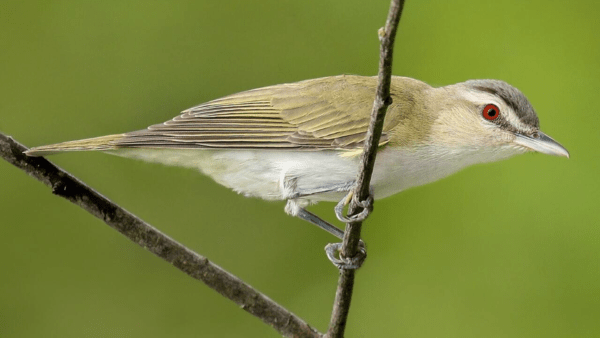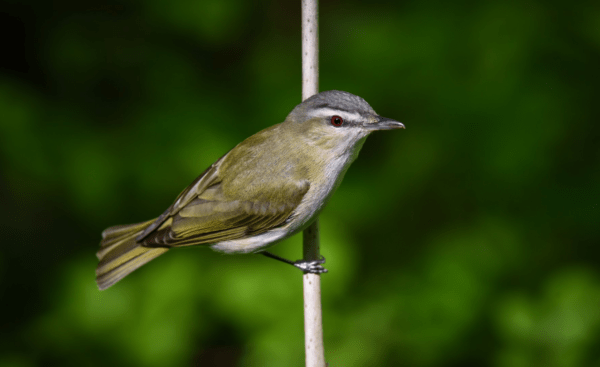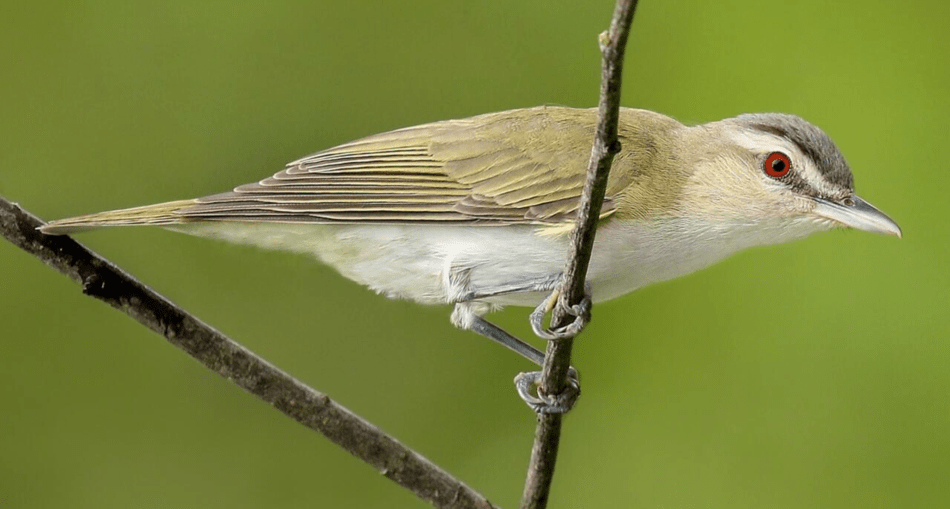The Red-eyed Vireo (Vireo olivaceus), a small but striking songbird, is a common sight in the forests of Guyana during migration.

The Red-eyed Vireo [Photo: Ryan Schain/Macaulay Library]
IDENTIFICATION AND DESCRIPTION
The Red-eyed Vireo is slightly larger than a Yellow Warbler but smaller than a Tufted Titmouse.
It has a chunky, stocky build with a long, angular head and a thick neck, making it stand out from other small songbirds.
The bill is strong and long, with a slight hook at the tip, perfect for catching its favourite prey – caterpillars.
The bird’s plumage is an attractive olive-green on the upper parts, with white underparts that give it a clean look.
One of its most defining features is its head pattern: a grey crown bordered by blackish lines, a white eyebrow stripe, and a dark line running through the eyes.
Its flanks and undertail carry a faint green-yellow wash. While adults sport red eyes, juveniles have dark eyes, making it easier to distinguish between them.
BEHAVIOUR AND SONG
The Red-eyed Vireo is one of the most prolific singers in the bird world. Known for its constant, rhythmic questioning song, it can sing over 20,000 times a day.
The song is made up of a series of 1-5 syllables, with an average of 31 song types per bird. This energetic singer often serenades from the treetops, making it easier for birdwatchers to locate.
Although the Red-eyed Vireo can be hard to spot in the dense canopy, its near-constant singing is a clue to its whereabouts.
It moves slowly, carefully scanning leaves for caterpillars and aphids, its main food sources.
It may also be seen attending mixed-species feeding flocks, where it joins other birds high up in the trees.
HABITAT IN GUYANA
In Guyana, Red-eyed Vireos are typically found in deciduous forests with large trees.
Red-eyed Vireos are known to be migratory. In Guyana, they are mostly seen between April and October.
DIET AND FEEDING HABITS
Red-eyed Vireos primarily feed on insects, particularly caterpillars and aphids. They can often be seen gleaning insects from the foliage of trees or hovering briefly to catch their prey.
Fruit trees such as tamanqueiro and gumbo-limbo attract them to parks and gardens in the tropics. In fact, their acrobatic feeding style, including hanging upside down to reach the fruit, is one of the bird’s most fascinating behaviours.
NESTING AND REPRODUCTION
This bird builds its nest in the fork of a tree branch, typically in the canopy. The nest is a delicate cup-shaped structure made of twigs and grasses.

However, this bird faces threats from parasitism, particularly from the Brown-headed Cowbird in the north and the Shiny Cowbird in the south. These parasitic birds lay their eggs in the nests of Red-eyed Vireos, sometimes at the expense of their own offspring.
CONSERVATION STATUS
Despite its wide distribution, the Red-eyed Vireo is not considered to be threatened. According to the IUCN, the species is of Least Concern, although local populations may be impacted by habitat loss and parasitism.
REFERENCES
- https://www.allaboutbirds.org/guide/Red-eyed_Vireo/id
- https://en.wikipedia.org/wiki/Red-eyed_vireo
- https://ebird.org/species/reevir1







